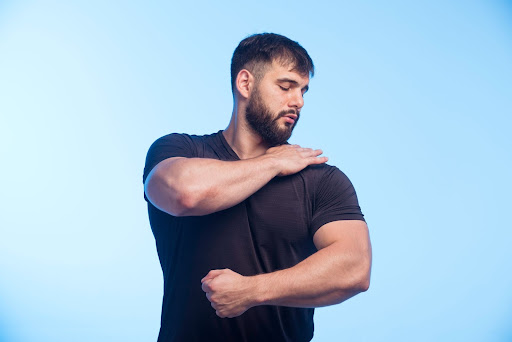
Shoulder pain is a commonplace disorder among athletes, both experts and beginners. Sports that contain repetitive overhead movements, which include tennis, swimming, baseball, and weightlifting, can put sizeable pressure on the shoulder joints and muscle groups, leading to pain and capability injuries.
In this text, we will discover the sector of sports-associated shoulder pain, specializing in prevention strategies and recuperation techniques that athletes can rent to keep their shoulders healthy and robust.
The Anatomy of Shoulder Pain
Before delving into prevention and recovery, it’s crucial to recognize the anatomy of the shoulder and the not unusual resources of aches.
The shoulder is a relative cell joint created from three bones: the humerus (upper arm bone), the scapula (shoulder blade), and the clavicle (collarbone). Several critical structures, such as tendons, ligaments, and muscle tissues, work together to facilitate movement.
However, this complexity additionally makes the shoulder susceptible to various accidents and situations.
Common causes of sports activities-associated shoulder pain include:
Rotator Cuff Injuries: The rotator cuff is a group of muscle groups and tendons that stabilizes and actions the shoulder joint. Overuse or traumatic events can result in tears or infection in those structures.
Labral Tears: The labrum is a cartilage ring that surrounds the shoulder socket. Athletes, particularly in sports activities like baseball and tennis, are prone to growing labral tears because of repetitive throwing or swinging motions.
Impingement Syndrome: This happens when the rotator cuff tendons or bursa come to be pinched or irritated, frequently because of repetitive overhead moves.
Frozen Shoulder (Adhesive Capsulitis): A circumstance characterized by way of stiffness, pain, and restrained range of movement in the shoulder joint, which could broaden after a duration of inaction or immobilization.
Preventing Shoulder Pain in Sports
Preventing shoulder pain in sports activities entails a combination of things, together with the right training strategies, warm-up workouts, and lifestyle selections. Here are a few key techniques:
Proper Technique: Athletes must receive expert education to make sure they are the usage of correct strategies. This includes the proper shape for overhead actions, which may notably lessen the danger of injury.
Gradual Progression: Avoid abrupt increases in schooling intensity or frequency. Gradually boom the load and duration of your workouts to permit your shoulder muscle tissues and tendons to adapt.
Warm-Up and Stretching: Always start your sports activities with a thorough warm-as much as growth blood goes with the flow and versatility inside the shoulder region. Dynamic stretching can assist in putting together the shoulder muscle groups for movement.
Strength and Conditioning: Include shoulder-specific strength and conditioning physical games for your training regimen. Focus on sporting activities that target the rotator cuff muscle tissues to enhance balance and save you from injuries.
Rest and Recovery: Adequate relaxation is critical for shoulder health. Ensure you have rest days on your schooling agenda and prioritize sleep to promote tissue restoration and ordinary recuperation.
Nutrition and Hydration: Maintain a balanced weight loss program and live nicely hydrated. Proper vitamins support tissue health, whilst dehydration can lead to muscle cramps and expanded harm risk.
Equipment Selection: Use appropriate sports gadgets and tools that suit you properly. Ill-becoming equipment can exacerbate shoulder troubles.
Cross-Training: Incorporate cross-schooling sports that work different muscle organizations and reduce the pressure on your shoulders. This diversification can help prevent overuse accidents.
Recovering from Shoulder Pain
If you do enjoy shoulder aches as an athlete, it’s important to address them directly to save you similar harm and facilitate a complete recuperation. Here are a few strategies for healing:
Ice and Heat: Apply ice packs to the affected vicinity inside the preliminary ranges of pain or irritation. Afterwards, use heat remedies to relax and soothe the muscle tissues.
Rest: Give your shoulder ok time to relax. Avoid sports that exacerbate pain, and remember to immobilize the shoulder with a sling or brace if endorsed by a healthcare expert.
Medication: Over-the-counter pain relievers, together with ibuprofen, can assist in reducing aches and irritation. Always talk with a healthcare issuer before taking any medicinal drug.
Physical Therapy: A physical therapist can create customised rehabilitation software that includes physical activities to enhance power, flexibility, and range of motion inside the shoulder.
Corticosteroid Injections: In a few cases, a healthcare provider may also suggest corticosteroid injections to reduce irritation and pain.
Surgery: For severe injuries or conditions, a surgical procedure can be necessary. Surgical options can vary from minimally invasive procedures to greater complicated surgeries, including rotator cuff upkeep or labral maintenance.
Rehabilitation and Gradual Return: After remedy, follow your physical therapist’s recommendations for a sluggish return to sports activities activities. Rushing the lower back too soon can result in re-harm.
Lifestyle Adjustments: Make the way of life adjustments as had to save your destiny shoulder problems. This may additionally consist of enhancing your schooling, enhancing posture, and keeping a healthy lifestyle.
Conclusion
Shoulder pain in sports activities is a common and regularly preventable difficulty. By information about the anatomy of the shoulder, recognizing common resources of pain, and implementing preventive measures, athletes can considerably reduce the chance of shoulder accidents.
In instances of damage, timely and suitable treatment is crucial for a hit recovery. Remember that in search for steerage from healthcare experts, coaches, and bodily therapists is crucial to cope with and prevent shoulder aches, allowing athletes to continue playing their sports activities even as keeping their shoulders healthy.






